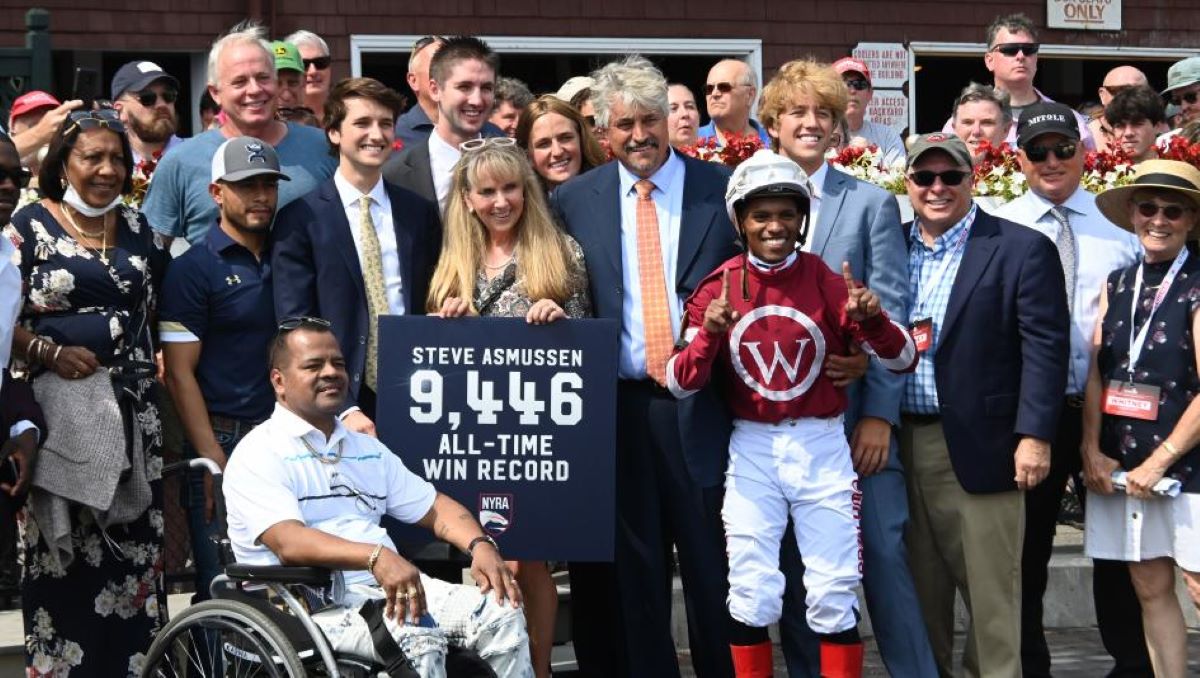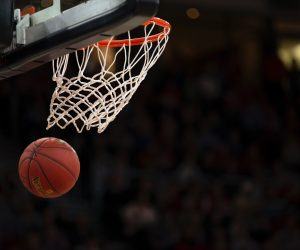Steve Asmussen used Saturday’s Whitney Day at Saratoga as his record-breaking canvas, becoming North America’s winningest Thoroughbred trainer by claiming his 9,446th career race. That leapfrogged the 14-year-old mark of 9,445 set by the late Dale Baird.

Stellar Tap did the honors for the Hall of Fame trainer. Owned by L and N Racing and Winchell Thoroughbreds – a longtime Asmussen client — the 2-year-old won Saratoga’s fifth race, a seven-furlong, maiden special weight by 5 ¼ lengths.
With Ricardo Santana Jr. aboard, the 5/1 third-favorite stalked pace-setting 6/5 favorite Brigadier General, putting him away at the half-mile pole. Stellar Tap pulled away down the stretch, breaking his maiden at first asking and paying $13 in the process.
“How fitting to do this with a 2-year-old owned by the Winchells and who came through Mom and Dad’s farm in Laredo (Texas), and on Whitney Day,†Asmussen said in a winner’s circle ceremony. “I was definitely blessed. I’m very proud of where I came from and don’t ever want to forget it. It makes you who you are. I love to be able to share this with my parents.â€
Racing is in the Asmussen DNA
Asmussen comes from a racing family. His parents, Keith and Marilyn, still run the Asmussen Horse Center and the El Primero Training Center in Laredo. Keith Asmussen is a former jockey and Marilyn is a former quarter-horse trainer. Steve’s older brother, Cash, won the 1979 Eclipse Award as Outstanding Apprentice Jockey.
The 55-year-old Asmussen began his career in the saddle, taking out his jockey’s license at 16. Asmussen rode 721 races in 27 months between 1984 and 1986, racking up $687,224, while winning 8% of his races. Four years later, in 1986, he began his training career at Ruidoso Downs in southern New Mexico. That first year, Asmussen went 1-for-15, with Victory’s Halo providing his first career victory.
Despite a slow start — it took him eight months to get Win No. 2 — this proved to be one of those proverbial “good career moves,” since trainer Asmussen wins at a 21% clip. The following year, Asmussen won his first stakes race when Scout Command took the Bessemer Stakes at the late Birmingham Race Course in Alabama. It took another nine years for Asmussen to score a graded-stakes victory. That came with Valid Expectations in the 1993 Grade 3 Derby Trial at Churchill Downs.
Asmussen’s operation covers the class pyramid
Then, the wins started coming as Asmussen’s operation expanded. He was slowly building the expansive operation that operated strings at tracks big, small, and in-between. It’s an Asmussen feature to run multiple horses at multiple tracks in multiple time zones on a daily basis. And he works with $10,000 claimers along with million-dollar Grade 1 contenders.
Dreams Galore brought Asmussen his first Grade 1 win, courtesy of her score in the 1999 Mother Goose at Belmont Park. By 2000, Asmussen had 1,000 wins. He hit 2,000 by 2003 and, in 2004, he broke Jack Van Berg’s record of 497 victories in a single year. He wound up with 555 victories that year.
Win No. 3,000 came in 2005. Triple Crown victory No. 1 came in 2007, when Curlin won the Preakness Stakes. Asmussen won his 4,000th race in 2008, the same year he took home his first of two Eclipse Awards for Outstanding Trainer. This was one of the biggest no-brainer votes in award history, considering Asmussen broke his own record — winning 621 races in 2008.
Rachel Alexandra made 2009 a year to remember
Somehow, Asmussen surpassed all of that in 2009. He won his 5,000th race, took the Preakness with filly Rachel Alexandra, and won a still-record 650 races. That brought his second Eclipse Award.
Win No, 6,000 came in 2011 and No. 7,000 in 2015. Asmussen was elected to the Hall of Fame in 2016, the same year Creator captured the Belmont for Asmussen’s third Triple Crown victory. Two years later, on the Kentucky Derby undercard, Asmussen won race No. 8,000. He hit 9,000 last September at Oklahoma’s Remington Park.
Asmussen tied Baird’s record on Friday, when Rafael Bejarano piloted 2/1 Shanghai’s Dream to the Ellis Park winner’s circle in a $19,500 claiming race.
Difference in paths to the same number
The record-tying and record-breaking races illustrate the difference between Asmussen and Baird. Again, Asmussen’s operation stretches from Fair Grounds in Louisiana through Remington Park in Oklahoma to the New York tracks – with stops in between at Oaklawn Park, Churchill Downs and elsewhere. Asmussen tied the record at Ellis Park and broke it at Saratoga.
On Saturday, Asmussen sent 14 horses to starting gates at four tracks, including Louisiana Downs, Saratoga, Monmouth Park, and Ellis Park. Asmussen’s horses ran in everything from an $8,000 claimer at Louisiana Downs (Policy Limit) to the $1 million Grade 1 Whitney Stakes at Saratoga (Silver State).
That pretty much describes how Asmussen amassed those 9,446 victories. For further comparison, Asmussen’s 9,446 victories produced more than $361 million in career earnings. Baird’s 9,445? A bit more than $35.3 million, according to Equibase.
Before his 2007 death in an Indiana auto accident, Baird rang up most of his 9,445 victories at West Virginia’s Mountaineer Park. And he rang them up largely in low-level claiming races, Mountaneer’s specialty. According to the Daily Racing Form, Baird never ran a graded-stakes race in his nearly 57,000 career starts.
Baird brought big-time results to small-time tracks
But, like Asmussen, who trained four Horses of the Year (Curlin twice, Rachel Alexandra, and Gun Runner), Baird knew his niche. He was the first North American trainer to win 300 races in a year and, as late as 2000, was second among North American trainers for wins in a year.
His MO was as simple as it was labor-intensive. Baird employed a conga-line of horses coming in from various farms in the Midwest and East. He’d buy horses, find races for them at Mountaineer, then spend 46 years rinsing and repeating the process.
And like Asmussen, Baird was a passionate horseman from a horse family. His father trained horses at various county fairs and his brother John, and John’s son, Mike, keep the family horse farm going with between 50 and 60 horses.
“Steve Asmussen, he’s every bit as driven as Dale was,†Michael Baird told the DRF. “For my dad and I, there are no sour grapes with us. The record was going to be broken anyway, and when it does get broke, I love it’s going to get broke by a real horseman.â€











